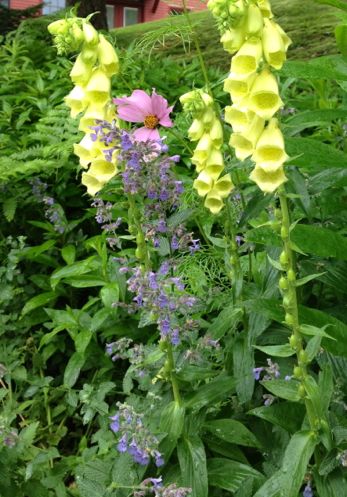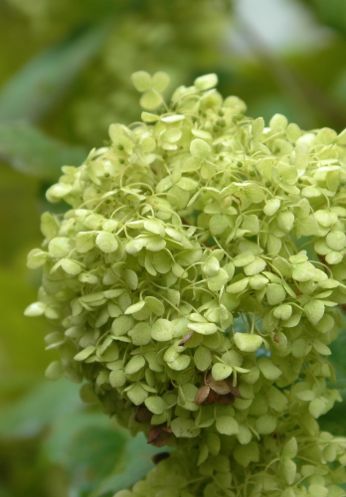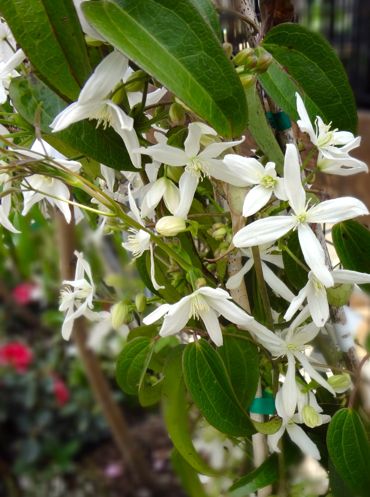April is Not So Cruel

If T.S. Eliot had spent Aprils in Washington he might have started “The Wasteland” out differently. In Washington, April is hardly, as he famously wrote, “the cruelest month, breeding lilacs from the dead land”.
At least not this past week or so, when days have been relatively warm and sunny, and the buds on every tree and shrub visibly swell with each passing hour. When it hit 80 degrees last week, I headed for the nursery.
This was my fourth nursery trip this year – and it is only April. My first was in mid-February when I wandered off to one of my favorite nurseries in Connecticut. Covered in snow, it was closed. In early March I found that though the nurseries here weren’t closed, they weren’t carrying much besides pansies and other annuals.

So last week, I was ready. I’ve just finished the long planned revision of my garden in which, to the horror of a surprisingly large body of friends, I replaced every blade of grass with gravel and paving. It’s lovely. Spacious and open, it has plenty of room for entertaining and lounging, as well as three tracts of empty soil just waiting to be planted.
My thought is to plant my garden in pale yellows and bluish greens, with lots of texture and, of course, year-round interest. For me, pale yellow does something special to a garden. It feigns sunlight in dark or dappled places, sets off brighter colors, and never seems to fade in the heat of a Washington summer day. Pale yellow and bluish greens are gorgeous together. I plan to have big pots of annuals, so my borders need to be neutral enough to work with anything I choose to put in the pots in the years to come. Orange, pink, white, apricot, and myriad other colors complement pale yellow and bluish green.
As I drove out River Road, the excitement of finally planting my new garden overwhelmed my training and experience as a garden designer. Discipline yielded to exuberance and impulse. I didn’t care. I had a serious case of gardener’s spring fever.

All winter I have dreamed of planting yellow Knockout roses. It’s a bit of an experiment because my garden is not especially sunny, but I can’t waitto try them in the one spot where perennial salvias bloomed last year (casualties, alas, of the excavation for the new stonework). Disease resistant Knockout roses start blooming in May and persist well into late fall when they finally succumb to the first serious frost.
I have also been thinking I might try Annabelle hydrangeas. They are not exactly yellow but a creamy white that fades to light green as summerprogresses. Then there are azaleas. And I wants lots of yellow foxgloves, euphorbias, forget-me-nots, ferns, hostas, toad-lilies and and and …
By the time I pulled into the crowded parking lot (I wasn’t the only one with spring fever) I had worked myself into a frenzy. I picked out a pair ofshovels and loaded five or six bags of potting soil in the car. Then, it was off to the plants. There were lots of early blooming perennials but I just couldn’t pick so I drifted up past the vines to the shrub department. The evergreen Armand’s clematis (Clematis armandii) was in full bloom (I had spotted it weeks ago on a fence in the East Village) but I wasn’t sure where I’d plant it or what its’ sun requirements are. There were no roses, no hydrangeas, no late summer blooming perennials like hostas. What a disappointment! Perhaps April is the cruelest month, I thought, after all.

Slowly, disappointment gave way to sanity. Other than a color palette, I had to admit I had no plan. I had no idea what I wanted to plant besides Knockouts, yellow foxgloves and hellebores. Did I even want shrubs? What was I thinking?
I slaked my plant appetite with begonias and clematis, and drove back to Georgetown silently lecturing myself about the need to make a planting plan so I could proceed exuberantly but sanely. I sternly reminded myself of my own planting rules.
First, I must make a list of what’s important in this space. If possible, every plant should have more than one season’s interest, especially in a small garden. That could be any combination of bark, foliage, inflorescence, texture, or berries. My second requirement is that everything has to be a super-favorite plant, a delight in deer-free garden.

Next comes the color palette. My summer palette will be yellow and blue, but it should change throughout the seasons. I love unrestrained color in early spring and lots of fall colors with a good dash of purple worked in for autumn. In winter it can be reds, whites, and even yellow or chartreuse.
Then I will make a list of all the perennials, trees, and shrubs, I want, based of course on my first two lists. It is important to have a good sense of the soil and sun/shade conditions before beginning this process. My list is long, but I surprised myself by I ruling out most shrubs and trees once I actually thought about it.
I will take this third list and sit in my garden to review and try to envision where each plant will be. My rule is that if you can’t envision it, it’s off the list. The final list usually needs one more cut if you are plant crazy. I know from experience that a garden often ends up looking like a plant sale or a pig’s breakfast when you try to fit everything in. It’s better to plant fewer different species boldly than to plant a little bit of a lot of different things.

Finally, I need to measure my borders and draw them to scale so I can mark down where my choices will be installed. You can take a photo of yourspace and mark that up if it is easier. This will help me determine quantities. Then I will return to the nursery to buy what is available on my list, leaving spaces for anything that won’t be in stock until later in the season. If you can’t bear empty spaces, you can always tuck a few annuals in as fillers.
A true gardener will always be tweaking and bringing home something new to tuck in somewhere, but as long as you have a plan, you will start the process off without too many costly mistakes. April is not so cruel after all.
